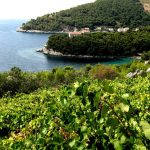Private owner immediately contacted the Trogir Museum, findings are still being researched.
After the storm caused by the archaeological findings in Split last month when the construction of a taxi stand uncovered findings for which the Conservation department director stated they were of great importance and then revoked his own clumsy statement, another archaeological site was uncovered in Trogir, also during construction works. On May 23, 2016, we spoke to the Trogir Museum to find out what kind of remains were found and whether they will also be covered up or extensively researched.
According to the Museum staff, they received a call last week informing them that workers have found the remains of Roman urns during the expansion of a private parking lot in the area of Put Dragulina, a street located in the path of the formerAncient Roman road that used to lead to the Trogir hinterland.

While they were expanding the parking lot, workers uncovered a number of graves along the northern and eastern side of the foundations, and even though some of them were damaged due to construction works, thanks to the relatively fast reaction from the owner who immediately stopped all works upon arriving to the site, 4 stone urns and several tombstones were left intact. A glass balsamary was found in one of the urns while a bronze needle was found among the bones in the second urn. It is believed several graves were destroyed during excavation works and material was taken to a dump site due to the fact that the owner was not present when construction works started.

Archaeologists state that their claim of the great density of graves on this site is confirmed by the remains visible in the profile of the excavated wall foundation where three more graves were noticed with deceased buried stone urns along with a damaged carved stone grave cover for which they believe to be a tombstone of one of the deceased. Until today, a total of 18 graves were found and since the archaeologists are still on location, they expect to find a few more.

This is an extremely important and rare find, one of the oldest discovered so far in the wider Trogir area that contains Roman graves. Material found can be dated back to the 1st century AD. And since the research on the segment of the west necropolis of the Roman Tragurium is still underway, this new finding will give us a closer look at Roman burial rituals as well as an insight into the family relations and social structures of that era. According to the first results, these new findings show members of the upper class were buried in this location.

This new site is not only significant in terms of its scientific importance, it will also help expand the existing Archaeological collection exhibited within the Trogir Museum, making it even more attractive to both locals and tourists.
All photos by Trogir Museum









